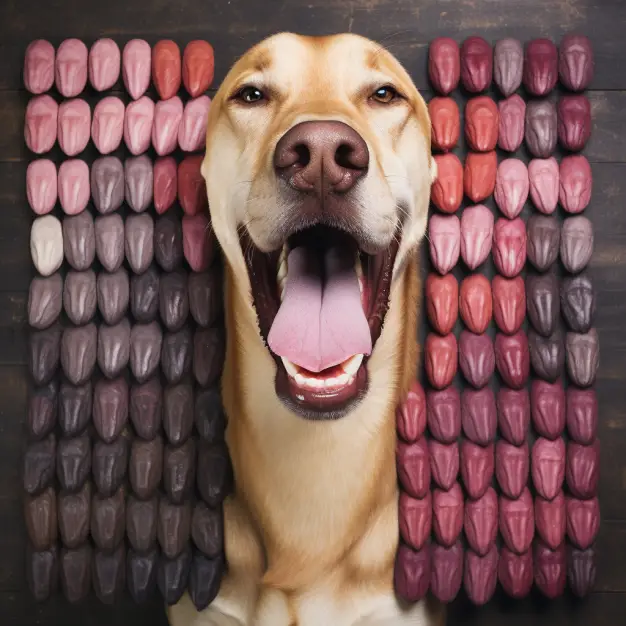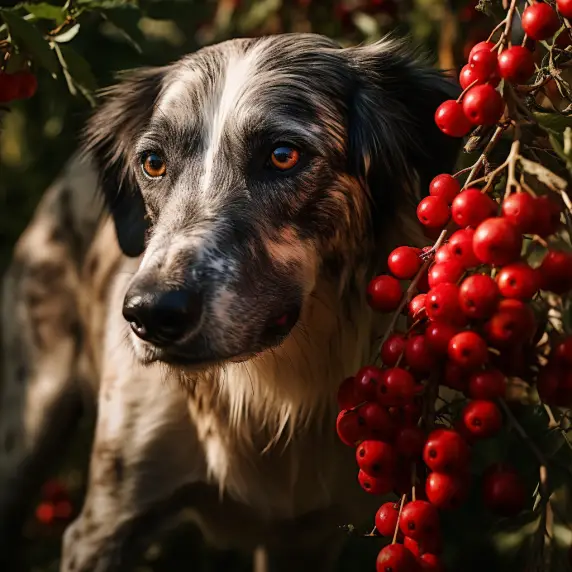Red Tongue in Dogs: 6 Causes & Interventions
Every pet owner knows that their dog’s health is paramount. One aspect of a dog’s health that might be overlooked, however, is the color of its tongue. The hue of a dog’s tongue can serve as a window into their overall health, providing clues about various conditions and potential issues.
This article aims to demystify the reasons behind a red tongue in dogs and offers actionable insights on addressing any associated health concerns. Recognizing changes in tongue color and understanding what they signify can be crucial in ensuring your furry friend’s well-being.
Short Answer: A red tongue in dogs can be indicative of several conditions ranging from mild concerns like overheating or mild irritation to more severe issues such as infections, blood disorders, or other underlying health problems. It’s crucial for pet owners to observe their dog’s tongue and mouth regularly and consult with a veterinarian if unusual changes are noticed. Proper diagnosis and timely intervention can make a significant difference in ensuring the dog’s health and comfort.
6 Common Causes of a Red Tongue in Dogs, Associated Symptoms & Interventions
The color and state of a dog’s tongue can serve as a telltale sign of their overall health. Several conditions can lead to a red tongue, each with its unique symptoms and treatment recommendations. Let’s explore these conditions in detail:
1. Heatstroke
One of the most immediate threats dogs face, especially during the hotter months, is heatstroke.
- Symptoms: Beyond just a red tongue, dogs may exhibit excessive panting, drooling, increased heart rate, dizziness, lethargy, or even collapse.
- Immediate Actions: If you suspect heatstroke, it’s crucial to act quickly. Move the dog to a cooler location, offer fresh water to drink, and use damp towels to cool the dog down. Monitor for Dog Red Tongue Panting as a continued sign of overheating and seek veterinary care immediately.
2. Dental and Gum Diseases
Oral health is a crucial aspect of a dog’s overall well-being, and dental diseases can manifest in several ways.
- Impact: Gum diseases can make the Dog’s Gums Red and cause the tongue to appear unhealthy. Plaque, tartar, and infections can lead to this discoloration.
- Preventive Measures: Regular dental check-ups, brushing your dog’s teeth, and providing dental chew toys can help maintain oral health.
3. Infections
From bacterial invasions to viral outbreaks, infections can severely impact a dog’s health.
- Differentiating Symptoms: While bacterial infections might result in pus or open sores in the mouth, viral infections can lead to more systemic symptoms. A red tongue, combined with Dog’s Lips Red, can signal a severe infection.
- Treatment Options: Depending on the type of infection, antibiotics or antiviral treatments will be prescribed by a veterinarian.
4. Trauma or Injuries
Accidental bites, burns, or wounds can also lead to an inflamed and red tongue.
- Identifying Symptoms: Visible marks, bleeding, or swelling can indicate trauma.
- First Aid Steps: Clean the wound gently with saline water and prevent the dog from further injuring the area. Seek veterinary attention for severe or non-healing wounds.
5. Respiratory Disorders
Dogs with breathing problems can often display changes in tongue color.
- Symptoms: Difficulty in breathing, excessive panting, and a redder-than-usual tongue.
- Signs to Watch Out For: Prolonged panting, wheezing, and extended periods of a red tongue even in cool environments.
6. Toxicity
Ingestion of toxic substances can be life-threatening for dogs.
- Common Household Toxins: Items like chocolate, grapes, certain plants, and some household cleaners can be harmful.
- Effects: Depending on the toxin, dogs can show varied symptoms, including a red tongue, drooling, vomiting, or even seizures.
- Emergency Response: If suspected poisoning occurs, consult a vet immediately, preferably with information about the ingested substance.
Dog Tongue Color: Indicators of Health and Well-being
Dog Tongue Color Chart
Every pet owner knows that the tongue of their furry friend is not just an essential tool for slobbering over toys or delivering slobbery kisses. It’s also a vital indicator of their overall health.
Per the illustrative tongue color chart for dogs below, it includes various shades from light pink to a dark, almost purplish hue. Each color can offer insights into the dog’s health, with variations indicating everything from dehydration to more severe health issues.

Dog Tongue Color Meaning
Much like humans, a dog’s tongue color can provide clues about their internal health. A healthy tongue should be a medium shade of pink without any dark spots or patches. Here’s a brief breakdown of what different colors might indicate:
- Light Pink: Generally indicates a healthy dog, but an excessively pale tongue can suggest anemia or lack of blood circulation.
- Bright Red: This might indicate overheating, fever, or a possible toxin exposure.
- Blue or Purple: A sign of oxygen deprivation and is a medical emergency.
- White or Pale: Could be an indication of anemia or other blood disorders.
Dark Pink Tongue Dog
A darker pink shade, while close to the natural hue, can sometimes indicate a state of heightened blood flow. It could be due to temporary reasons like excitement, recent physical activity, or even slight dehydration.
However, if the dark pink color persists, it might be a sign of a systemic issue, like early stages of heatstroke, and warrants a vet visit.
Dog’s Tongue Darker Than Normal
If you observe that your dog’s tongue has suddenly turned a shade darker than its usual color, it’s crucial to monitor other symptoms. This change might be due to reasons like exposure to certain foods, dyes, or toys.
Some medications or treatments might also cause a darker hue. However, persistent darkness, especially with accompanying symptoms like lethargy or loss of appetite, might indicate potential health risks like hemangiomas, a type of benign growth, or more severe conditions like cancer.
Dog Tongue Red Around Edges
A tongue that is red or inflamed, especially around the edges, might be a sign of various conditions. Some potential causes include stomatitis (an oral inflammatory condition), periodontal disease, or even trauma.
In some cases, it could also indicate a more systemic issue like a blood disorder. If the redness is accompanied by other symptoms like drooling, difficulty eating, bad breath, or pawing at the mouth, it’s time to consult your veterinarian.
Specific Symptoms and Their Implications
Dog Tongue Red Around Edges
Noticing your dog’s tongue red around its edges can be alarming. While a minor inflammation or allergic reaction to a new food or chew toy might be the culprit, persistent redness can suggest a more serious underlying issue.
This redness might indicate conditions like oral ulcers, gingivitis, or even an autoimmune disorder.
It’s essential to monitor for accompanying symptoms like excessive drooling, reluctance to eat, or visible discomfort. If the redness doesn’t fade in a day or two, or if it appears suddenly with other signs of distress, a visit to the vet becomes essential.
Red Tongue Dogs Symptoms
A dog’s tongue can exhibit various symptoms, each hinting at different potential health concerns:
- Spotted or Patchy Redness: Might indicate localized irritation or potential injury.
- Swollen and Red: This combination often suggests an allergic reaction.
- Uniform Bright Redness: Could indicate fever, overheating, or possible toxin exposure.
Monitoring the accompanying behaviors, such as eating habits, energy levels, and other physical symptoms, can provide clarity on the severity and potential causes.
Dog Red Tongue Panting
Dogs pant to cool themselves, and it’s not uncommon for the tongue to appear redder during these times due to increased blood flow.
However, if your dog’s tongue looks exceptionally red while panting and they show signs of distress, lethargy, or disorientation, they might be experiencing heatstroke, a potentially life-threatening condition.
Unhealthy Dog Tongue
An unhealthy tongue in dogs might be discolored, patchy, or coated. Persistent bad breath, lesions, or a change in texture can also indicate issues ranging from dental problems to fungal infections or even more systemic concerns. Any abrupt or drastic change in your dog’s tongue warrants a vet check-up.
Dog’s Gums Red
Red gums can be a sign of gingivitis, a common gum disease in dogs. Left untreated, gingivitis can progress to periodontitis, which can lead to tooth loss. But red gums might also indicate a more systemic issue like blood disorders or infections.
Checking the dog’s gums regularly and ensuring they maintain a healthy pink color is crucial for early detection of potential problems.
Dog’s Lips Red
If a dog’s lips appear redder than usual, it might be due to local irritations, allergies, or potential infections. In some cases, trauma or bites can also cause localized redness. It’s essential to inspect the area for any swellings, discharge, or injuries.
If redness persists, worsens, or is accompanied by other symptoms, consulting with a veterinarian is a wise decision.
Interesting Facts About a Dog’s Tongue
The dog’s tongue is a fascinating organ, playing multiple roles in their day-to-day life. Beyond its apparent functions related to food and water intake, the tongue has several other intriguing characteristics that might surprise even the most seasoned dog lovers.
Anatomy and Unique Features
A dog’s tongue is more than just a soft, spongy tissue. It consists of muscles that give it flexibility and strength. Here are some unique features:
- Papillae: These tiny, bristle-like projections assist in grooming and food manipulation. They can also provide clues about a dog’s health.
- Taste Buds: Dogs have fewer taste buds than humans (around 1,700 compared to our 9,000), which is why they’re less picky about flavors.
- Lyssa: This is a thin, rod-like structure in the middle of the tongue, believed to provide structural support.
Role in Temperature Regulation
Dogs don’t sweat like humans. One of their primary ways to cool down is through panting, where the tongue plays a crucial role.
- Evaporative Cooling: As a dog pants, moisture on the tongue evaporates, which helps lower the body temperature.
- Increased Blood Flow: The tongue has an extensive network of blood vessels. When a dog pants, these vessels expand, allowing for more significant heat exchange and cooling.
Healing Properties of Dog’s Saliva
You’ve probably heard the old saying that a dog’s mouth is cleaner than a human’s. While this isn’t entirely accurate, there’s a reason behind the myth.
- Enzymes: Dog saliva contains specific enzymes that combat harmful bacteria, potentially reducing the risk of infection in small wounds.
- Wound Cleaning: The act of a dog licking its wound can help clear out debris, although excessive licking can delay the healing process.
- Natural Antibiotics: Some studies suggest that dog saliva has compounds that act as natural antibiotics, though this doesn’t mean it should replace traditional wound care!
This multifunctional organ, thus, plays an essential role in a dog’s health, well-being, and even their interactions with the world around them.
Steps to Take When Noticing a Red Tongue in Your Dog
Upon observing a red tongue in your dog, it’s vital to address the situation with a combination of immediate action and ongoing monitoring. Recognizing and responding to this potential sign of distress can be critical for your dog’s well-being.
Immediate Care
A red tongue can sometimes signal immediate health concerns, especially if it’s a result of overheating or other acute issues.
- Cooling Down Procedures for Suspected Heatstroke: If your dog has been out in the sun or shows signs of distress along with a red tongue, it’s crucial to move them to a cooler environment immediately. Find a shaded spot, preferably indoors with good ventilation or air conditioning.
- Offering Water or an Ice Cube: Keeping your dog hydrated is essential. Provide fresh water and, if they’re reluctant to drink, consider offering an ice cube to lick, ensuring it cools them down without overwhelming their system.
Consultation
Should the redness persist or if it’s accompanied by other alarming symptoms, it’s essential to seek professional advice.
- Importance of Reaching Out to a Veterinarian: Continuous redness or any sign of distress is a clear indicator that your pet needs professional care. It’s always better to be safe and consult with a vet.
- Preparing for the Consultation: Before the appointment, jot down any additional symptoms you’ve observed and note recent activities or exposures that might be relevant, like new foods, exposure to chemicals, or interactions with other animals.
Ongoing Monitoring
While an immediate response is vital, it’s equally crucial to keep a close eye on your dog’s tongue color and overall health in the longer term.
- Tracking the Tongue’s Color Changes: Observe if the redness subsides after some time or if it becomes a recurring issue. Also, note if it is associated with specific activities or times of the day.
- Importance of Regular Health Check-ups: Like humans, dogs benefit from routine health checks. Regular visits to the vet can catch potential issues early and ensure that your furry friend remains in the best possible health.
Importance of Oral Health in Dogs
Oral health is paramount for dogs, just as it is for humans. A dog’s mouth serves many purposes – from the intake of nutrition to expressing affection and even as a tool for play. Thus, maintaining the health of this vital organ system is crucial for ensuring their overall well-being.
Connection Between Oral and Overall Health
The state of a dog’s mouth can be a window to their general health. Bacteria from untreated oral diseases can enter the bloodstream and affect the heart, kidneys, and liver. This can lead to more severe health problems if not addressed.
Common Oral Health Issues in Dogs
While a red tongue can be a sign, other symptoms might indicate oral health issues:
- Periodontal Disease: This is the most common dental condition in dogs. When food particles and bacteria accumulate along the gum line, it can lead to plaque, which can progress into a hardened tartar. If not treated, this can cause gum infections, loss of teeth, and even bone loss.
- Oral Tumors: Dogs can also develop tumors in their mouth. Regular check-ups are essential to detect and treat them early.
- Bad Breath (Halitosis): Contrary to popular belief, it’s not normal for dogs to have foul breath. Persistent bad breath can indicate that something is amiss, often pointing to gum disease or even digestive issues.
Daily Dental Care
Consistent dental care can prevent many of the common oral health issues in dogs.
- Brushing: Using dog-specific toothbrushes and toothpaste, regular brushing can significantly reduce the risk of dental diseases.
- Dental Treats and Toys: Certain chew toys and treats are designed to help clean your dog’s teeth as they play or eat, offering a fun yet effective way to support oral health.
- Professional Cleaning: Even with consistent home care, professional cleanings by a veterinarian can help address tartar build-up and check for early signs of dental problems.
Significance of Monitoring
Being observant can save your dog a lot of pain and discomfort. Regularly checking your dog’s mouth for signs of redness, swelling, bleeding, or any lumps will ensure that any issues are detected early and addressed promptly.
In conclusion, a dog’s oral health plays a pivotal role in their overall well-being. Regular check-ups, a consistent cleaning regimen, and a keen eye for symptoms are the pillars of ensuring that your canine companion remains happy and healthy.

10 Prevention and General Care Tips
Preventative care is key when it comes to maintaining your dog’s health, especially in the realm of oral hygiene. A proactive approach can help you avoid potential issues, or at least catch them early on. Here’s how you can ensure your dog’s tongue and mouth remain in top shape:
1. Regular Brushing
- Using a dog-friendly toothbrush and toothpaste, brush your dog’s teeth at least a few times a week. This removes food particles and bacteria, reducing the risk of dental diseases.
- Introduce brushing gradually to make it a positive experience for your dog.
2. Provide Dental Chews and Toys
- Dental chews help in naturally scraping off plaque and tartar build-up.
- Toys made from rubber or nylon can also help clean the teeth as your dog chews.
3. Quality Diet
- Feed your dog a balanced diet with quality ingredients. Some dog foods are specially formulated to promote dental health.
- Avoid giving them too many sugary treats.
4. Regular Veterinary Check-ups
- Aim for at least one dental check-up a year, where the vet will inspect your dog’s mouth for any early signs of issues.
- Sometimes, a professional dental cleaning might be necessary.
5. Clean Water Supply
- Always ensure your dog has access to fresh, clean water. This helps in flushing out food particles from the mouth.
- Some pet owners add dental additives to water, which can help reduce bacteria in the mouth.
6. Oral Gels and Sprays
- There are dog-specific oral gels and sprays available in the market that can help reduce bacteria and maintain gum health.
7. Be Observant
- Keep an eye out for signs of oral discomfort in your dog. This includes avoiding toys or food, excessive drooling, or pawing at the mouth.
- Check their mouth periodically for any discoloration, lumps, or sores.
8. Avoid Harmful Chews
- Bones, antlers, or hooves can be too hard for some dogs, potentially leading to broken teeth or injuries. Stick to softer, dog-approved chews.
9. Hydration
- A well-hydrated dog is less likely to have a dry mouth, which can lead to increased bacterial growth. Ensure they have regular access to water, especially after exercise.
10. Educate Yourself
Stay informed about common dental problems in dogs. The more you know, the better you can care for your furry friend.
By adhering to these preventative measures and care tips, you not only ensure the health of your dog’s mouth but also contribute positively to their overall well-being.
FAQs on Red tongue in Dogs
How do you know if your dog has a tongue infection?
Signs of a tongue infection in dogs may include swelling, redness, unusual discharge, bleeding, bad breath, and refusal to eat or drink. If you notice any of these symptoms, it’s essential to consult with your veterinarian promptly.
What to do if your dog’s tongue is hot?
A hot tongue can be a sign of fever or overheating. Make sure your dog is in a cool environment and has access to fresh water. If the tongue remains hot, or if there are other signs of distress, reach out to your veterinarian.
Why is my dog’s tongue dark red after surgery?
A dark red tongue following surgery can indicate a decrease in oxygen or an increase in carbon dioxide in the blood. It’s crucial to monitor your dog closely and inform the veterinarian immediately if you observe this change post-surgery.
What does the color of your tongue mean?
The tongue’s color can be an indicator of health. A healthy dog tongue is typically wet and pink. Variations in color, such as pale, blue, or dark red, can signify various health issues, from dehydration to more severe conditions like cyanosis or anemia.
Why is my dog’s tongue darker red than usual?
A darker red tongue can be due to several reasons, including overheating, stress, or certain health conditions. If your dog’s tongue remains dark red and is accompanied by other symptoms, it’s essential to seek veterinary care.
Can certain foods cause my dog’s tongue to change color?
While certain foods might temporarily stain a dog’s tongue (like beets), persistent color changes are typically not due to diet. However, allergic reactions to specific foods might cause tongue or gum inflammation. Always monitor your dog after introducing new foods.
How can I ensure my dog’s oral health is optimal?
Regular teeth brushing, providing dental chews, ensuring a balanced diet, and having routine veterinary dental check-ups are some of the ways to maintain optimal oral health for your dog.
Are there breeds more prone to tongue discolorations?
Some breeds, like the Chow Chow and the Shar Pei, naturally have blue-black tongues. It’s always essential to be familiar with your dog breed’s characteristics and consult with a vet if you notice sudden or unusual changes in tongue color.
Conclusion
A dog’s tongue, much like our own, is a telling indicator of their overall health and well-being. Changes in its color, especially a shift to red, can be alarming and might point towards underlying health issues.
As responsible pet owners, staying informed about potential causes and symptoms, and knowing when to consult a veterinarian, can make all the difference in ensuring our furry friends lead a healthy, vibrant life.
While some color shifts might be temporary or harmless, others could be warning signs. Always prioritize your dog’s oral health, and don’t hesitate to seek professional advice when in doubt.
Remember, an ounce of prevention is worth a pound of cure, especially when it comes to the health and happiness of our beloved companions.






